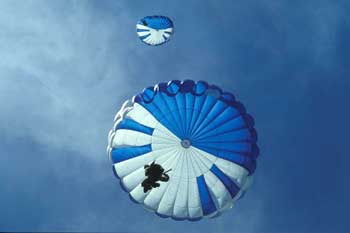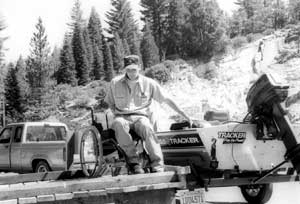Missoula Technology and Development Center: Shaping Solutions for the Forest Service
Problems Solved by the Missoula Technology and Development Center
Although these photographs show boat ramps, parachutes, all-terrain vehicles, and similar devices, the products the center produces are often prototypes. Mechanical drawings, specifications, reports, videos, Web sites, and CDs allow others to reproduce the center's successes. Each year, the center distributes more than 100,000 copies of its reports, videos, CDs, and technical drawings.

Traditional skills, such as felling trees with a crosscut saw,
are lost as experienced Forest Service employees retire.
The center helps maintain these skills by producing videos,
publishing reports, and preparing training materials.

Firefighters rappel from helicopters using equipment
developed by the center. The use of rappelling has been growing
in recent years.

Mechanical engineer Mary Ann Davies sets up portable
air quality testing devices in the Bitterroot Valley.
These devices give results immediately.
With standard devices,
results usually aren't available for a day or more.
With the new devices,
public health officials could notify the public the moment
air quality deteriorates.

Center personnel conduct a pull test for the
Federal Aviation Administration
during the 1980s. This test shows that the center's anchor
for parachute static lines can safely handle anticipated loads.
Nearly every smokejumper aircraft used by the Forest Service
has been equipped with modifications designed by the center.

Forest Service smokejumpers have softer landings
and
can get closer to their target using a new parachute
developed by the center in cooperation with a parachute design firm.
The parachute is the first round chute that can fly backward.
It has been so successful that it has also been adopted by the U.S. Army.

All chemical products (such as retardants, foams, and gels)
for wildland firefighting must be proven safe and effective
before the Forest Service qualifies them for use. This wind tunnel
test of the effectiveness of fire retardant is one of many tests
the center conducts on each product.

Special panniers make it easier to carry and dump gravel
during trail construction in the backcountry. Trail construction
is also aided by drawings of equipment for pack stock,
a series of videos, and a trail construction notebook
published by the center.

Physiologist Dr. Brian Sharkey measures the extra work
required
for a firefighter to breathe while wearing a respirator
at the University of Montana's Human Performance Laboratory.
Among the results of Sharkey's studies for the center
over the past three decades have been the step and pack tests
that measure the fitness of firefighters. Now,
Sharkey
and his colleagues at the university are studying the effects
of the arduous duties of firefighting on immune function and fatigue.

Forest Service employees often rely on global positioning system
receivers to determine their location. Over the past 20 years,
the center has worked closely with manufacturers
to improve
the accuracy of receivers under tree cover and in mountainous terrain.
The center tests receivers at several carefully surveyed test courses,
including one at the University of Montana's Lubrecht Experimental Forest
30 miles east of Missoula.

Operators on all-terrain vehicles can maintain lanes
and trails using accessories developed by the center.

Photovoltaic cells are being tested for lighting at fire camps.
The cells aren't powerful enough to replace generators,
but they can quietly charge batteries for lights on trails to sleeping areas.

The Forest Service needs effective ways to start fires
as well as to put them out. In some cases,
helicopters
carrying torches that dispense gelled gasoline
are safer and quicker than the alternative
of having firefighters
on the ground do the job.

Carefully conducted tests determine how much retardant actually
ends up on the fuels when retardant delivery systems are used
under a variety of conditions. These tests allow fire managers
to order retardant drops in a way that's likely to do the most good
for the least cost.

Sociologist Dr. Jon Driessen interviews experienced employees
for a video instructing drivers who transport firefighters
to wildland fires.
Over the past three decades, Driessen,
a University of Montana professor, and his graduate students
have conducted studies that formed the basis for training programs
to help Forest Service employees adapt to a changing workplace.

This prototype machine injected steam into the soil at
Forest Service nurseries, killing disease organisms.
The machine was developed to reduce the need for fumigation
with ethyl bromide. Although the prototype worked,
it would need
a larger boiler to be practical.

Unlike most commercial yarders, the Bitterroot miniyarder
is small enough to be hauled behind a pickup truck. It was developed
by the center to allow loggers to pull small-diameter trees from the
forest more economically.

Accessible loading platforms make it easier for people with
limited mobility to get in and out of boats. Once boaters have
boarded,
the boat is backed to the water for launching.
This platform and drawings were developed by the center.

The center's fabrication shop allows us
to produce
prototypes of new products.
